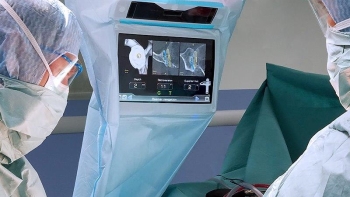Robert Wood Johnson University Hospital Rahway and Orthopedic Surgeon Dr. Mina Abdelshahed recently became the first hospital and surgeon in the state to perform total shoulder replacement surgery using a guided three-dimensional system to help with more precise placement of the shoulder implant.
 The ExactechGPS® Guided Personalized Surgery provides surgeons with
real-time visual guidance and alignment data in total shoulder surgery,
giving the surgical team a three-dimensional view of the shoulder and
the progress of the surgery. The system’s preoperative planning
tool also allows surgeons to plan their cases in advance of the surgery
through a virtual simulation. Surgeons can then execute their plan in
real time during the surgery based on a 3-D anatomical model of the patient’s
shoulder, making adjustments as needed. The technology is a compact, standalone,
touch screen tablet and proprietary camera that integrates into the sterile
field for easy access and improved line of sight.
The ExactechGPS® Guided Personalized Surgery provides surgeons with
real-time visual guidance and alignment data in total shoulder surgery,
giving the surgical team a three-dimensional view of the shoulder and
the progress of the surgery. The system’s preoperative planning
tool also allows surgeons to plan their cases in advance of the surgery
through a virtual simulation. Surgeons can then execute their plan in
real time during the surgery based on a 3-D anatomical model of the patient’s
shoulder, making adjustments as needed. The technology is a compact, standalone,
touch screen tablet and proprietary camera that integrates into the sterile
field for easy access and improved line of sight.
Shoulder replacement surgery is complicated because the physiology of the shoulder makes it difficult for the surgeon to see what is behind the bone and adjust for variances that may not have been visible in pre-operative CT scans or X-Rays. Personalized for a patient’s unique bone structure and anatomy, ExactechGPS is designed to allow surgeons to decide where to remove bone and place the shoulder implant in the optimal position.
Before this technology, surgeons reviewed CT scans and X-rays to develop a surgical plan based on the patient’s condition, but during surgery, things can look different.
“This technology makes me even more precise,” said Dr. Abdelshahed, a surgeon with Union County Orthopedics. “It helps me determine where exactly to drill the central cage and how much of the bone I need to shave away to perfectly place the shoulder replacement.”
Precise placement affects not only the patient’s range of motion, but reduces wear and tear on the shoulder replacement. “You want it perfectly placed and perfectly fitted because you want it to last as long as possible,” said Dr. Abdelshahed, who specializes in orthopedic, reconstructive and arthroscopic surgery; shoulder surgery and replacement; reverse shoulder replacement and treatment of torn tendons and ligaments.
The ExactechGPS Shoulder Application has been used successfully in the United Kingdom, Spain, France and Australia. The first U.S. cases were performed in June 2017.